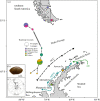Gene flow in the Antarctic bivalve Aequiyoldia eightsii (Jay, 1839) suggests a role for the Antarctic Peninsula Coastal Current in larval dispersal
- PMID: 33047024
- PMCID: PMC7540763
- DOI: 10.1098/rsos.200603
Gene flow in the Antarctic bivalve Aequiyoldia eightsii (Jay, 1839) suggests a role for the Antarctic Peninsula Coastal Current in larval dispersal
Abstract
The Antarctic Circumpolar Current (ACC) dominates the open-ocean circulation of the Southern Ocean, and both isolates and connects the Southern Ocean biodiversity. However, the impact on biological processes of other Southern Ocean currents is less clear. Adjacent to the West Antarctic Peninsula (WAP), the ACC flows offshore in a northeastward direction, whereas the Antarctic Peninsula Coastal Current (APCC) follows a complex circulation pattern along the coast, with topographically influenced deflections depending on the area. Using genomic data, we estimated genetic structure and migration rates between populations of the benthic bivalve Aequiyoldia eightsii from the shallows of southern South America and the WAP to test the role of the ACC and the APCC in its dispersal. We found strong genetic structure across the ACC (between southern South America and Antarctica) and moderate structure between populations of the WAP. Migration rates along the WAP were consistent with the APCC being important for species dispersal. Along with supporting current knowledge about ocean circulation models at the WAP, migration from the tip of the Antarctic Peninsula to the Bellingshausen Sea highlights the complexities of Southern Ocean circulation. This study provides novel biological evidence of a role of the APCC as a driver of species dispersal and highlights the power of genomic data for aiding in the understanding of the influence of complex oceanographic processes in shaping the population structure of marine species.
Keywords: Antarctic Peninsula Coastal Current; NexTRAD; assymetrical migration.
© 2020 The Authors.
Conflict of interest statement
We declare we have no competing interests.
Figures



Similar articles
-
Hydroids (Cnidaria, Hydrozoa) from Mauritanian Coral Mounds.Zootaxa. 2020 Nov 16;4878(3):zootaxa.4878.3.2. doi: 10.11646/zootaxa.4878.3.2. Zootaxa. 2020. PMID: 33311142
-
The Antarctic Circumpolar Current isolates and connects: Structured circumpolarity in the sea star Glabraster antarctica.Ecol Evol. 2018 Oct 12;8(21):10621-10633. doi: 10.1002/ece3.4551. eCollection 2018 Nov. Ecol Evol. 2018. PMID: 30464833 Free PMC article.
-
Phylogeography and genetic diversity of the microbivalve Kidderia subquadrata, reveals new data from West Antarctic Peninsula.Sci Rep. 2021 Mar 11;11(1):5705. doi: 10.1038/s41598-021-85042-7. Sci Rep. 2021. PMID: 33707560 Free PMC article.
-
Marine pelagic ecosystems: the west Antarctic Peninsula.Philos Trans R Soc Lond B Biol Sci. 2007 Jan 29;362(1477):67-94. doi: 10.1098/rstb.2006.1955. Philos Trans R Soc Lond B Biol Sci. 2007. PMID: 17405208 Free PMC article. Review.
-
Shelf-ocean exchange and hydrography west of the Antarctic Peninsula: a review.Philos Trans A Math Phys Eng Sci. 2018 Jun 28;376(2122):20170164. doi: 10.1098/rsta.2017.0164. Philos Trans A Math Phys Eng Sci. 2018. PMID: 29760109 Free PMC article. Review.
Cited by
-
Interpopulational differences in the nutritional condition of Aequiyoldia eightsii (Protobranchia: Nuculanidae) from the Western Antarctic Peninsula during austral summer.PeerJ. 2021 Dec 21;9:e12679. doi: 10.7717/peerj.12679. eCollection 2021. PeerJ. 2021. PMID: 35036155 Free PMC article.
-
Mitochondrial Heteroplasmy and PCR Amplification Bias Lead to Wrong Species Delimitation with High Confidence in the South American and Antarctic Marine Bivalve Aequiyoldia eightsii Species Complex.Genes (Basel). 2023 Apr 18;14(4):935. doi: 10.3390/genes14040935. Genes (Basel). 2023. PMID: 37107693 Free PMC article.
-
A molecular perspective on the invasibility of the southern ocean benthos: The impact of hypoxia and temperature on gene expression in South American and Antarctic Aequiyoldia bivalves.Front Physiol. 2023 Feb 21;14:1083240. doi: 10.3389/fphys.2023.1083240. eCollection 2023. Front Physiol. 2023. PMID: 36895632 Free PMC article.
-
The Intertidal North-South Split: Oceanographic Features and Life History Shape the Phylogeography of Chiton Acanthochitona rubrolineata.Evol Appl. 2025 Mar 31;18(4):e70095. doi: 10.1111/eva.70095. eCollection 2025 Apr. Evol Appl. 2025. PMID: 40171542 Free PMC article.
-
Thyasirid species composition (Bivalvia: Thyasiridae) and genetic connectivity of Parathyasira equalis (A. E. Verrill & K. J. Bush, 1898) in deep basins of sub-Arctic fjords.BMC Ecol Evol. 2024 Jul 4;24(1):91. doi: 10.1186/s12862-024-02278-3. BMC Ecol Evol. 2024. PMID: 38965473 Free PMC article.
References
-
- Clarke A, Crame J. 1989. The origin of the Southern Ocean marine fauna. J. Geol. Soc. Lond. 47, 253–268. (10.1144/GSL.SP.1989.047.01.19) - DOI
-
- González-Wevar CA, et al. 2017. Following the Antarctic Circumpolar Current: patterns and processes in the biogeography of the limpet Nacella (Mollusca: Patellogastropoda) across the Southern Ocean. J. Biogeogr. 44, 861–874. (10.1111/jbi.12908) - DOI
Associated data
LinkOut - more resources
Full Text Sources
Other Literature Sources

